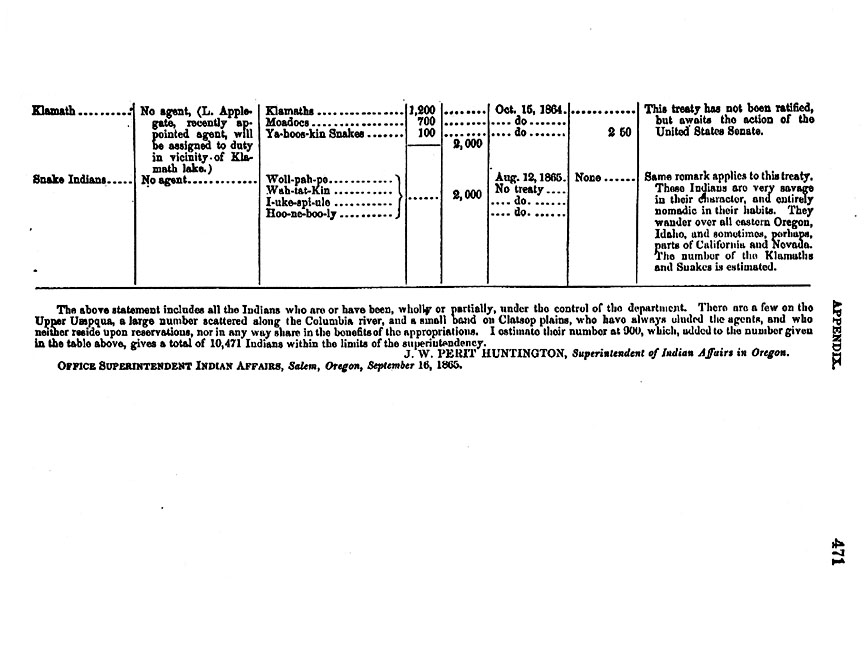- Catalog No. —
- ARCIA 1865-471
- Date —
- 1865
- Era —
- 1846-1880 (Treaties, Civil War, and Immigration)
- Themes —
- Environment and Natural Resources, Native Americans, Oregon Trail and Resettlement
- Credits —
- U.S. Office of Indian Affairs
- Regions —
- Southeast
- Author —
- J.W. Perit Huntington
Census of Indians in Eastern Oregon, 1865
This 1865 document is an excerpt from the annual report of Oregon’s Superintendent of Indian Affairs, J.W. Perit Huntington. It includes a partial census of Indians in southeastern Oregon and the Klamath Basin.
Huntington estimated that there were 2,100 “Snake Indians” living in eastern Oregon in 1865. The great majority of these people were probably Northern Paiute, a culturally diverse group of peoples united by a common language. The Northern Paiute live in southeastern Oregon, Nevada, and eastern California.
Huntington divided the “Snake Indians” of eastern Oregon into five groups, the Woll-pah-pe, the Wah-tat-Kin, the I-uke-spi-ule, the Hoo-ne-boo-ly, and the Ya-hoos-kin. There is disagreement among scholars as to the precise identity of these groups. The terms “Ya-hoos-kin” (Yahooskin) and “Woll-pah-pe” (Walpapi) probably refer to several different Northern Paiute and possibly Klamath groups that lived in present-day Lake County and eastern Klamath County. The descendants of these groups are part of the Klamath Tribes.
Huntington’s Wah-tat-Kin may refer to a Northern Paiute group generally known today as the Wadatika. A 1939 study by anthropologist T.D. Stewart refers to all of the Native peoples in the vicinity of Harney and Malheur lakes as the “Wadatoka,” or “Wada Seed Eaters.” However, anthropologists Julian Steward and Erminie Wheeler-Voegelin argue that it “is inconceivable that a single band could have exploited this great region as an organized group.” They suggest that Indians in this area were probably not organized by band or tribe but rather highly fluid family and camp groups.
Although the precise social organization and territorial boundaries of the Wadatika are still in question, it is clear that there was a large population of Native people in the Harney and Malheur lakes region prior to white settlement. While traveling in the vicinity of Harney and Malheur lakes in 1826, fur trader Peter Skene Odgen remarked that “it is incredible the number of Indians in this quarter. We cannot go 10 yds. without finding them. Huts generally of grass of a size to hold 6 or 8 persons. No Indian nation so numerous as these in all North America.”
In an oral history of her people, Paiute elder Marion Louie noted that “there was a great nation of Paiutes before the coming of the white men. Every spring and summer they all gathered in the Harney Lake region to harvest the little black seed known as ‘Wada.’ This gave the name of ‘Wada Dikaa’ to the band of Paiutes who lived in this location.” Today most Wadatika live on or near the Burns Paiute Reservation.
Further Reading:
Fowler, Catherine S., and Sven Liljeblad. “Northern Paiute.” In Handbook of North American Indians. Vol. 11, Great Basin. Edited by William C. Sturtevant. Washington, D.C.: Smithsonian Institution, 1986.
Louie, Marion. “History of the Malheur Paiutes.” In A Lively Little History of Harney County. Translated by Minerva Soucie; edited by the Centennial Committee. Burns, Oreg., 1989.
Steward, Julian H., and Erminie Wheeler-Voegelin. “The Northern Paiute Indians.” In Paiute Indians. Vol. III. New York, N.Y., 1974.
Written by Cain Allen, © Oregon Historical Society, 2005.
